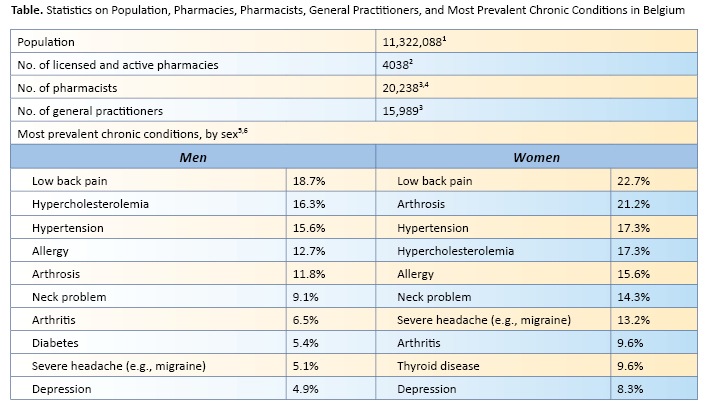
On March 15, 2017, Belgian community pharmacists signed a multiyear agreement with the Belgian Ministry of Public Health.1 A first milestone in implementing this agreement was introducing the family pharmacist concept.
Under this concept, since October 1, 2017, patients with chronic conditions in Belgium have been able to choose a community pharmacist as their family pharmacist and to sign a convention with him or her. The service consists of the pharmacist’s keeping up a complete and validated medication plan for each patient and providing it to patients and their health care team. An annual fee of €31.80 ($35.59) per patient is paid a posteriori.
Pharmacies offering the service are required to connect to the shared pharmaceutical record, a digital data sharing tool among community pharmacists. Funded and developed by Belgian national community pharmacists’ associations, this tool was rolled out in 2013. By the launch of the family pharmacist service in October 2017, 93% of all community pharmacies in Belgium had been connected to the tool and their accounts activated. One year later, connection rates were up to 99.9% and activation rates, up to 97.3%. The shared pharmaceutical record allows access to dispensing data in connected community pharmacies, provided patients have activated their informed consent for digital data sharing, which is included in the family pharmacist convention.
Systematic and structured registration of active medications, including posology and – if available – indication, allows the digital sharing of medication plans. Family pharmacists are dedicated to registering all prescription and nonprescription drugs as well as all relevant nutritional supplements and medical devices. These pharmacists then share the medication plans – digitally, if possible – with patients, their general practitioners, and, when applicable, nurses and hospital staff. Providing general practitioners, nurses, and hospital staff with reliable information about patients’ actual medication use is of value in itself, given that none of these entities has had access to full patient medication data until now.
Data about the number of conventions included in this new service were collected through traditional flows of health insurance and reimbursement for community pharmacists (please see the Table for other relevant statistics). Connection of participating pharmacies to the shared pharmaceutical record was measured through the contracting of this tool as well as through the monitoring of the actual activity therein.
Between October 1, 2017, and September 30, 2018, 577,111 conventions were registered in a sample of 93% of all community pharmacies in Belgium. After extrapolation, an estimated 610,000 patients were registered, with over 1 in 20 Belgian citizens and about 1 in 4 patients with chronic conditions having signed up for the service by the end of the first year after its launch. The mean number of patients who chose a family pharmacist per pharmacy was 122 and the median, 72. Over 96% of all pharmacies registered at least one convention.
The new service was immediately adopted by most community pharmacists and was well accepted by patients. Moreover, a small-scale survey showed that drawing up a medication plan led to the detection of inappropriate moments of intake, inappropriate dosing, untreated interactions, and even double medications in almost all of the participating pharmacies. Testimonials show that through deprescribing (of up to 8 of 15 medications!), clinical outcomes and quality of life can be improved.

1Data from General Directorate Statistics-Statistics Belgium, as of January 1, 2017. Available at https://statbel.fgov.be/nl/nieuws/belgie-2017-11322088-inwoners.
2Association of Pharmacists in Belgium (APB) database, as of July 2018.
3Data from report on annual statistics of health care professionals. Federal Public Service Health, 2017. Available at http://overlegorganen.gezondheid.belgie.be/sites/default/files/documents/statan_2017_nl.pdf.
4Estimated number of community pharmacists is 18,000.
5Data from the 2013 national health survey. Available at https://his.wiv-isp.be/nl/gedeelde%20%20documenten/ma_nl_2013.pdf.
6According to the survey, 28.5% of Belgian citizens older than 15 years had one or more chronic conditions. This percentage was significantly higher in women (31.1%) than in men (25.8%).
1Office of Pharmacies Cooperatives of Belgium (OPHACO) and Association of Pharmacists in Belgium (APB). Multiyear Framework for the Patient with Community Pharmacists [in French], March 15, 2017. Available at www.deblock.belgium.be/sites/default/files/articles/2017_03_15%20Cadre%20pluriannuel%20pharmaciens_web.pdf.